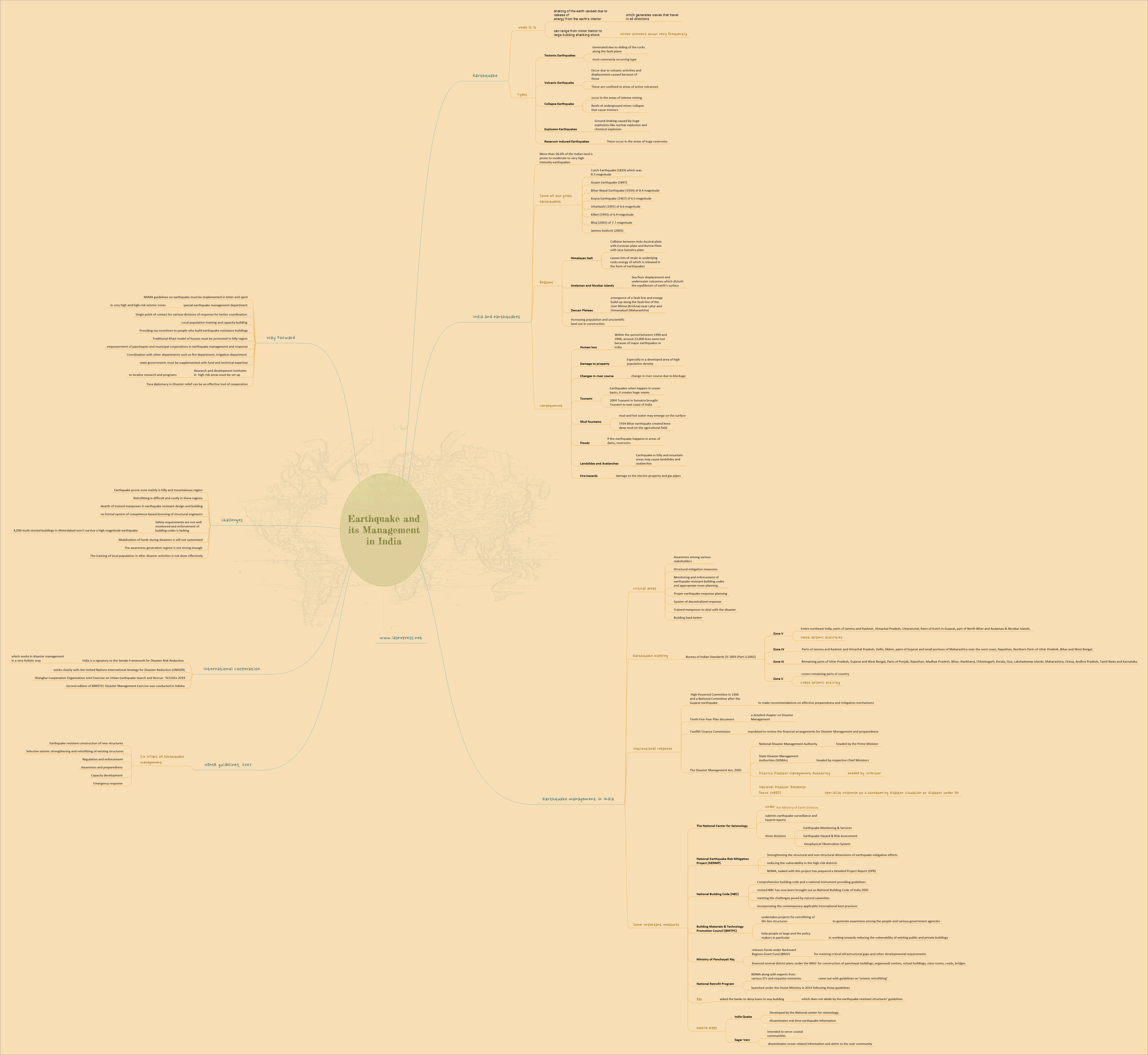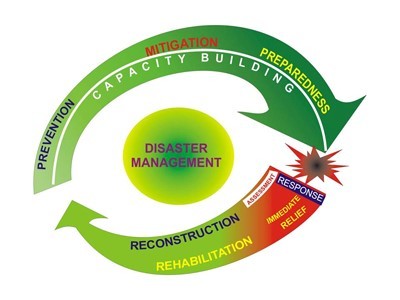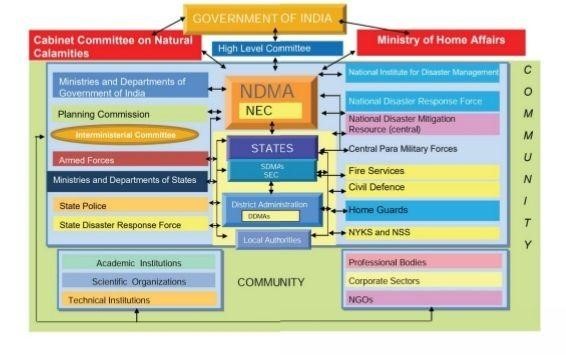Among the disasters earthquakes are by far the most unpredictable and destructible. India has seen some of the greatest earthquakes in the last century. The turning of the century brought devastating Bhuj earthquake in 2001. Earthquakes are a prominent danger in India’s disaster profile which has caused huge loss of life and material. Recently, powerful tremors were felt in India following an earthquake of magnitude 6.6 that struck Nepal, killing a few people and destroying many homes.

 Hence first comes the awareness of earthquake-prone areas. Earthquake mapping is an essential component of that awareness regime.
Hence first comes the awareness of earthquake-prone areas. Earthquake mapping is an essential component of that awareness regime.


What are Earthquakes?
- An earthquake is shaking of the earth caused due to the release of energy from the earth’s interior, which generates waves that travel in all directions.
- An earthquake can range from minor tremors to large building shanking shock.
- Minor tremors caused by small vibrations occur every few minutes but great earthquakes happen because of faulting (Normal, reverse and strike-slip) cause a great number of disruptions.
What are the various types of the earthquake?
- Tectonic Earthquakes
- Generated due to sliding of the rocks along the fault plane.
- This is the most commonly occurring type of earthquake.
- Volcanic Earthquake
- Occur due to volcanic activities and displacement caused because of those.
- These are confined to areas of active volcanoes.
- Collapse Earthquake
- These occur in the areas of intense mining.
- Roofs of underground mines collapse that cause tremors.
- Explosion Earthquakes
- Reservoir induced Earthquakes
India and earthquakes
- India has had its share in some of the devastating earthquakes.
- More than 58.6% of the Indian land is prone to moderate to very high-intensity earthquakes.
- Some of the great earthquakes in India
- Cutch Earthquake (1819) which was 8.3 magnitude
- Assam Earthquake (1897)
- Bihar-Nepal Earthquake (1934) of 8.4 magnitude
- Koyna Earthquake (1967) of 6.5 magnitude
- Uttarkashi (1991) of 6.6 magnitude
- Killari (1993) of 6.4 magnitude
- Bhuj (2001) of 7.7 magnitude
- Jammu Kashmir (2005)
What are the reasons for the Earthquakes in India?
- Himalayan belt– Collision between Indo-Austral plate with Eurasian plate and Burma Plate with Java Sumatra plate. This collision causes lots of strain in underlying rocks’ energy of which is released in the form of earthquakes.
- Andaman and Nicobar Islands– Seafloor displacement and underwater volcanoes which disturb the equilibrium of earth’s surface
- Deccan Plateau– some earth scientists have come up with a theory of the emergence of a fault line and energy build-up along the fault line of the river Bhima (Krishna) near Latur and Osmanabad (Maharashtra).
- Increasing population and unscientific land use in construction make India a high-risk land for earthquakes.
What are the consequences of an earthquake?
Earthquake is characterized by suddenness, scale, and magnitude. These three characters make it extremely dangerous when it comes to life and property without any discrimination. The impacts of the earthquake can be summarized as below- Human loss
- Damage to property
- Changes in the river course
- Tsunami
- Mud fountains
- Floods
- Landslides and Avalanches
- Fire hazards
Earthquake management in India
Earthquake management in India, Disaster management for that matter, goes through different stages. Some of the critical areas of earthquake management in India are- Awareness among various stakeholders
- Structural mitigation measures
- Monitoring and enforcement of earthquake-resistant building codes and appropriate town planning.
- Proper earthquake response planning
- System of decentralized response
- Trained manpower to deal with the disaster
- Building back better
 Hence first comes the awareness of earthquake-prone areas. Earthquake mapping is an essential component of that awareness regime.
Hence first comes the awareness of earthquake-prone areas. Earthquake mapping is an essential component of that awareness regime.
Earthquake mapping in India
Bureau of Indian Standards [IS 1893 (Part I):2002], has divided the country into four seismic zones, Zone-II, III, IV and V. Zone V is the most active region and zone II is the least seismically active region.- Zone V
- Zone IV
- Zone III
- Zone II covers remaining parts of the country
- The Indian government set up a High-Powered Committee in 1999 and a National Committee after the Gujarat earthquake, to make recommendations on effective preparedness and mitigation mechanisms.
- The Tenth Five-Year Plan document included a detailed chapter on Disaster Management.
- The Twelfth Finance Commission was mandated to review the financial arrangements for Disaster Management and preparedness.
- In December 2005, the Disaster Management Act was enacted
- National Disaster Management Authority (NDMA), headed by the Prime Minister
- State Disaster Management Authorities (SDMAs) headed by respective Chief Ministers to do the same at the state level.
- Earthquake is an essential part of India’s disaster preparedness challenges.
- Structure of NDMA

Some Important measures to prevent and mitigate earthquake loss
- The National Center for Seismology
- An office of the Ministry of Earth Sciences. It submits earthquake surveillance and hazard reports to governmental agencies.
- It includes three divisions: Earthquake Monitoring & Services, Earthquake Hazard & Risk Assessment, Geophysical Observation System.
- National Earthquake Risk Mitigation Project (NERMP)
- Strengthening the structural and non-structural dimensions of earthquake mitigation efforts.
- reducing the vulnerability in the high-risk districts.
- Necessary risk mitigation measures are put in place in the highly seismic zones.
- NDMA, tasked with this project has prepared a Detailed Project Report (DPR).
- National Building Code (NBC)
- Comprehensive building code and a national instrument providing guidelines for regulating the building construction activities across the country.
- First published in 1970 at the instance of the Planning Commission and was revised in 1983. Thereafter three major amendments, two in1987 and the third in 1997 were issued.
- The revised NBC has now been brought out as National Building Code of India 2005 (NBC 2005).
- The salient features are meeting the challenges posed by natural calamities and incorporating the contemporary applicable international best practices.
- Building Materials & Technology Promotion Council (BMTPC)
- undertakes projects for retrofitting of life-line structures to generate awareness among the people and various government agencies.
- aimed to help people at large and the policymakers in particular in working towards reducing the vulnerability of lakhs of existing public and private buildings.
- Initiatives by Ministry of Panchayati Raj
- It releases funds under Backward Regions Grant Fund (BRGF) for meeting critical infrastructural gaps and other developmental requirements.
- The ministry has financed several district plans under the BRGF for construction of panchayat buildings, Anganwadi centres, school buildings, classrooms, roads, bridges, culverts, etc. and restructuring of State Institutes for Rural Development (SIRD) buildings, block resource centres, panchayat training centers, etc.
- National Retrofit Program
- The RBI had asked the banks to deny loans to any building which does not abide by the earthquake resistant structures’ guidelines.
- The government launched two Mobile apps
- ‘India Quake’– Developed by the National center for seismology, the mobile app disseminates real-time earthquake information.
- ‘Sagar Vani’-Intended to serve coastal communities, the mobile app disseminates ocean related information and alerts to the user community in a timely manner for their safety.
- TheNational Disaster Response Force (NDRF) strives to be the first responder at heritage sites, which are vulnerable to disasters such as earthquakes, floods, cyclones, and tsunami across India.
- Earthquake resistant construction of new structures.
- Selective seismic strengthening and retrofitting of existing structures.
- Regulation and enforcement.
- Awareness and preparedness.
- Capacity development.
- Emergency response.
International cooperation in earthquake preparedness
- India is a signatory to the Sendai Framework for Disaster Risk Reduction which works in disaster management in a very holistic way.
- India works closely with the United Nations International Strategy for Disaster Reduction (UNISDR).
- Shanghai Cooperation Organization Joint Exercise on Urban Earthquake Search and Rescue- ‘SCOJtEx-2019’ was held in New Delhi.
- The second edition of BIMSTEC Disaster Management Exercise was conducted in Odisha.
Challenges in Earthquake management in India
- The Earthquake-prone zone mainly is a hilly and mountainous region. Retrofitting is difficult and costly in these regions
- There is a dearth of trained manpower in earthquake resistant design and building.
- There is no formal system of competency-based licensing of structural engineers.
- Safety requirements are not well monitored and enforcement of building codes is lacking.
- NDMA said that close to 4,000 multi-storied buildings in Ahmedabad won’t survive a high magnitude earthquake due to a faulty design.
- The mobilization of funds during disasters is still not systemized. The national disaster relief Fund is not publicized enough.
- Difficulty in response coordination in Uttarakhand floods showcases gaps in disaster response regime.
- The awareness generation regime is not strong enough. The training of the local population after disaster activities has not been done effectively.
Way forward
- The NDMA guidelines on earthquake must be implemented in letter and spirit.
- A special earthquake management department must be created in very high and high-risk seismic zones.
- The traditional Khasi model of houses must be promoted in the hilly region.
- Providing tax incentives to people who build earthquake resistance buildings.
- A single point of contact for various divisions of response for better coordination must be developed.
- Local population training and capacity building must be done.
- An effective way to do that would be the empowerment of panchayats and municipal corporations in earthquake management and response.
- Coordination with other departments such as fire department, Irrigation department to negate any after-effects of earthquakes.
- The state governments must be supplemented with the fund and technical expertise.
- Research and development institutes in states like Uttarakhand and other high-risk areas must be set up to localize research and programs.
- Para diplomacy in Disaster relief can be an effective tool of cooperation for high-risk prone states.

Responses